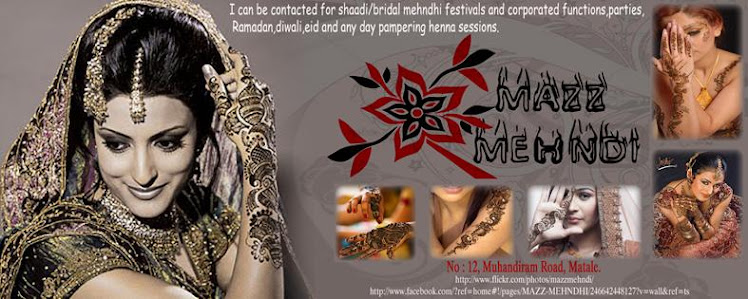Mehndi (or mehendi or mehandi or mylanchi) is the application of henna as a temporary form of skin decoration, most popular in South Asia, the Middle East, North Africa and Somali land as well as expatriate communities from these areas. It is typically employed for special occasions, particularly weddings. It is usually drawn on the hands and feet, where the designs will last the longest due to the fact that it only penetrates the dead cells of the stratum corneum.
Mehndi (Henna) is a natural product comes from a bush called Lawsonia Inermis. A plant, growing in size from 3 to 5 feet and can vary slightly from region to region. Its leaves are then dried and ground to make the henna powder. Since it is a natural product, there are no known side effects. Henna is used for hair dye, as a skin conditioner and as a reliever for rashes. The art of Mehndi is referred to henna as well, depending on where you are and which name you feel came first. No matter what you call it though, the art form remains essentially the same as it was centuries ago. It is beautiful the way it stains the skin!
Unlike other black pigment tattoos, Mehndi is not a huge commitment because of its temporary nature. For people who are too scared to endure the poking of a needle or are too ambivalent to commit to wearing the same permanent design forever, Mehndi is a wonderful alternative.
In India, it is used in a celebration like Weddings, Diwali, Navratri, Eid, Teej or Karva Chauth festival and other special occasions. It also used for worship. The patterns of Mehndi are typically quite intricate and predominantly applied to brides before wedding ceremonies. However, traditions in India, Pakistan, Bangladesh, and Sudan sometimes expect bridegrooms to be painted as well. In Rajasthan (northwest India), where Mehndi is a very ancient folk-art, the grooms are given designs which are often as elaborate as those for brides. In Kerala (South India), Henna is known as Mylanchi and is commonly used by the Mappila community during weddings and festivals. In other countries, such as Morocco, it is done for any special occasion. It is done during the 7th month of pregnancy (henna is believed to protect and bless the mother and child from any evil or malicious spirits that may be near during delivery), after having the baby, weddings, engagements, family get-togethers, as well as many other reasons to simply celebrate an event.
In modern era, Mehndi is also very popular for a Valentine’s Day, a formal party, ladies party or even an evening at a disco. Belly Mehndi, is an excellent modern addition to blessing way, baby shower or Belly Blessings ceremony. In its new avatar, Mehndi has been elevated to the status of body art and a fashion accessory for the fashion-conscious youngsters.
When we are talking about natural Mehndi (Henna), lets talk about Black Mehndi (Black Henna) as well. The henna powder is made by drying and grinding the leaves of a henna plant (lawsonia inermis). "Black Henna" has other ingredients than natural henna added in them. A chemical dye called Para-Phenylenediamine, referred to as PPD, is often used to create a fast-taking, jet-black result. Unfortunately PPD is very harmful on skin, often causing a so-called chemical burn. This is much like a strong allergic reaction, many people get it and many don't, but it is advisable not to take the risk. A black henna burn takes a long time to get better and often leaves a scar. Please stay away from these products and stick to the pure henna. Allergic reactions of the henna are very rare, it is safe to use and the result is beautiful.

No comments:
Post a Comment